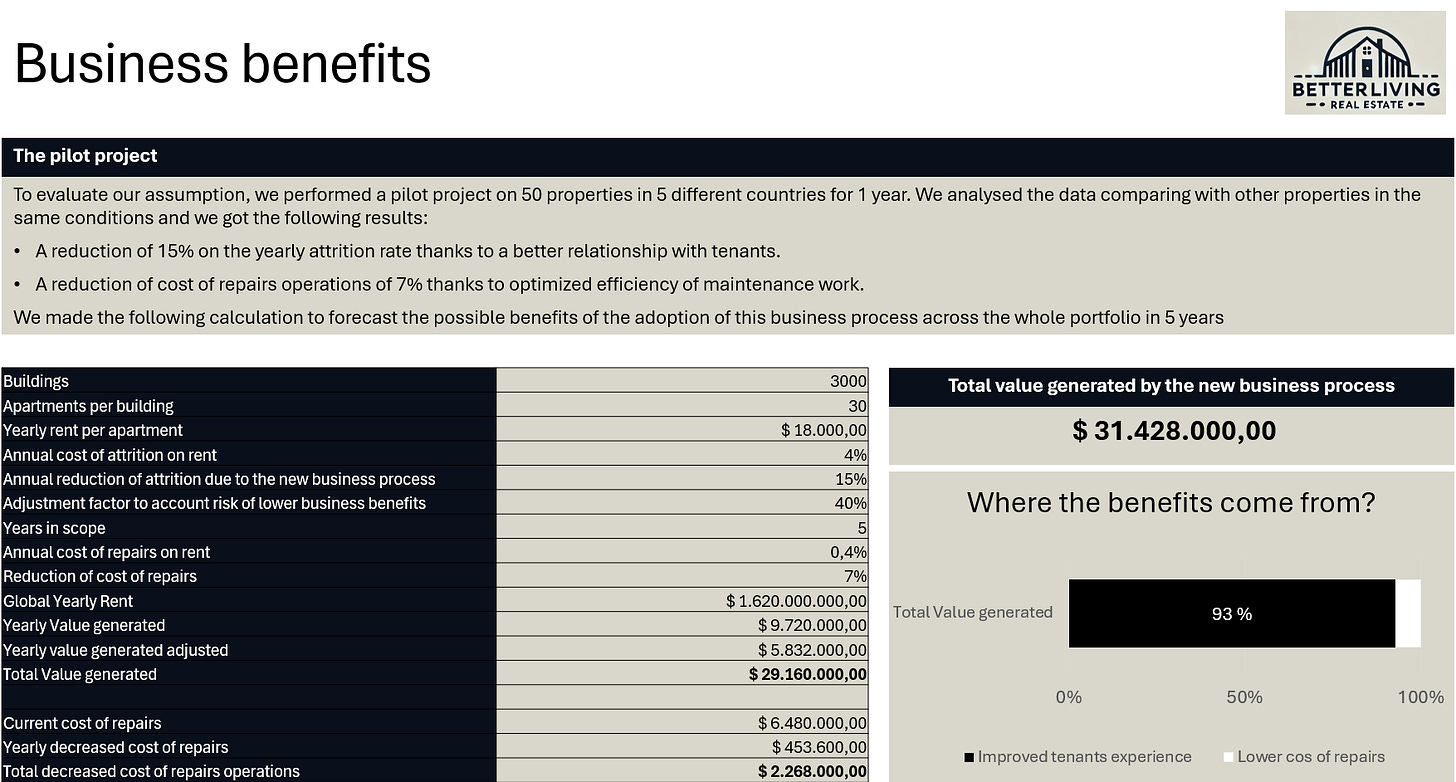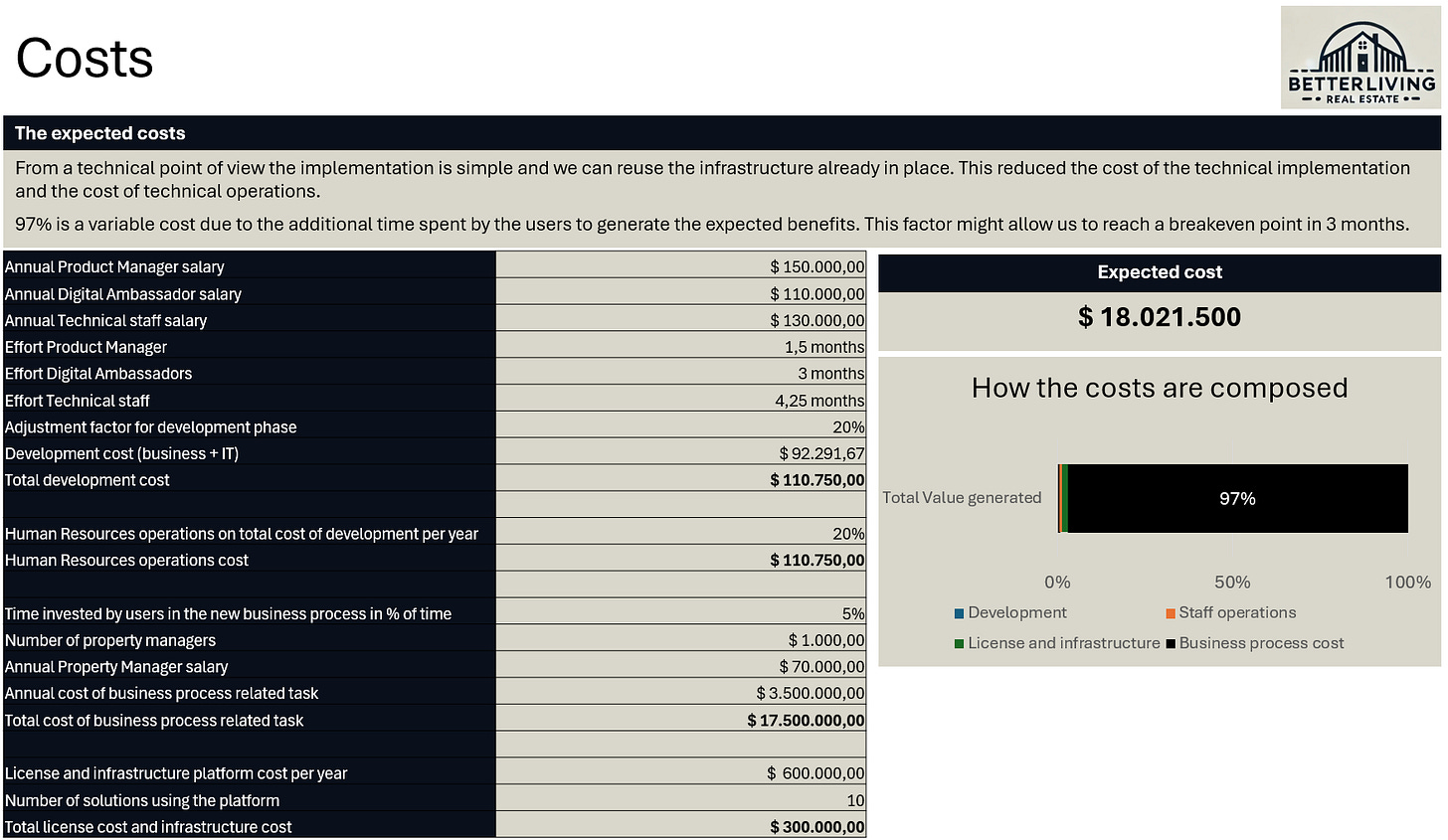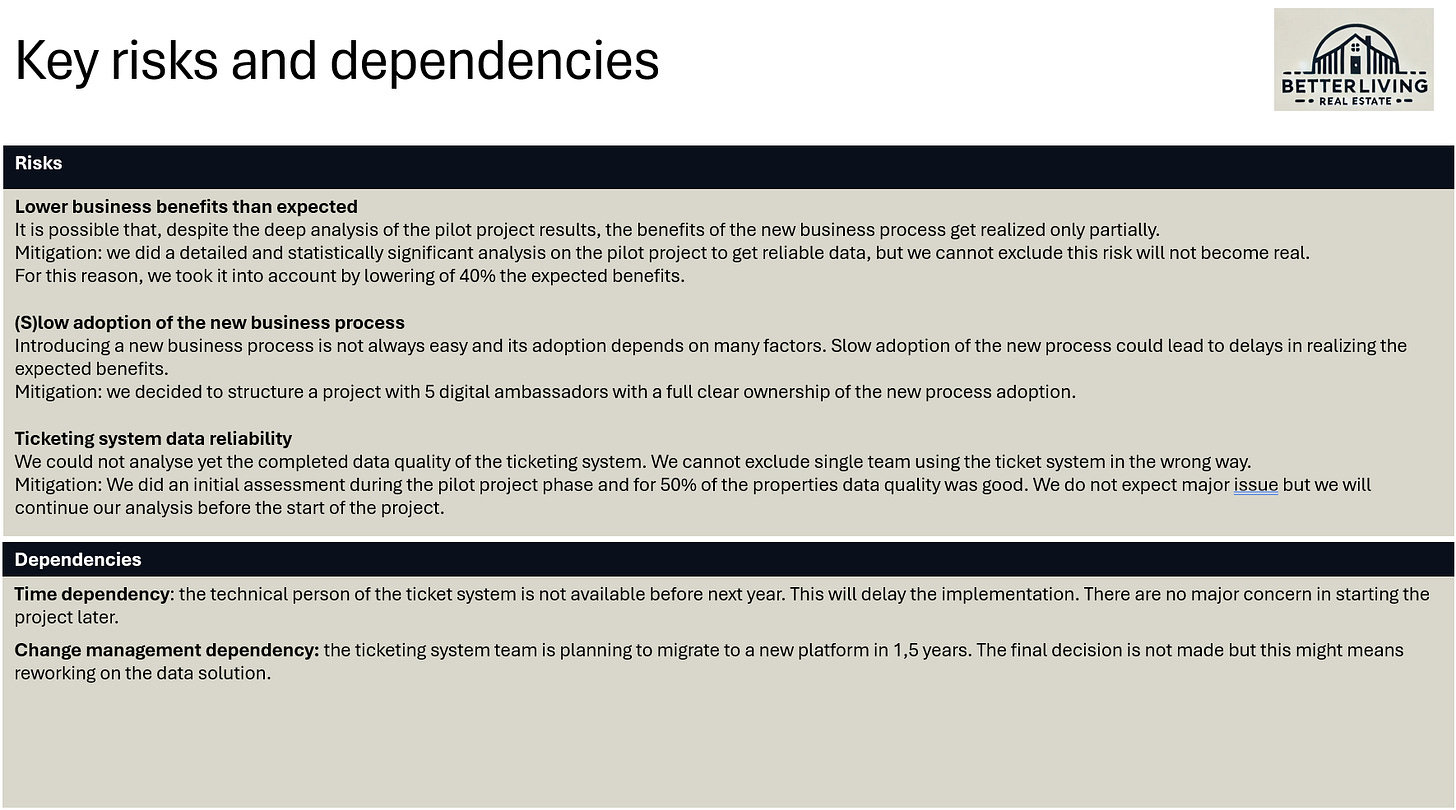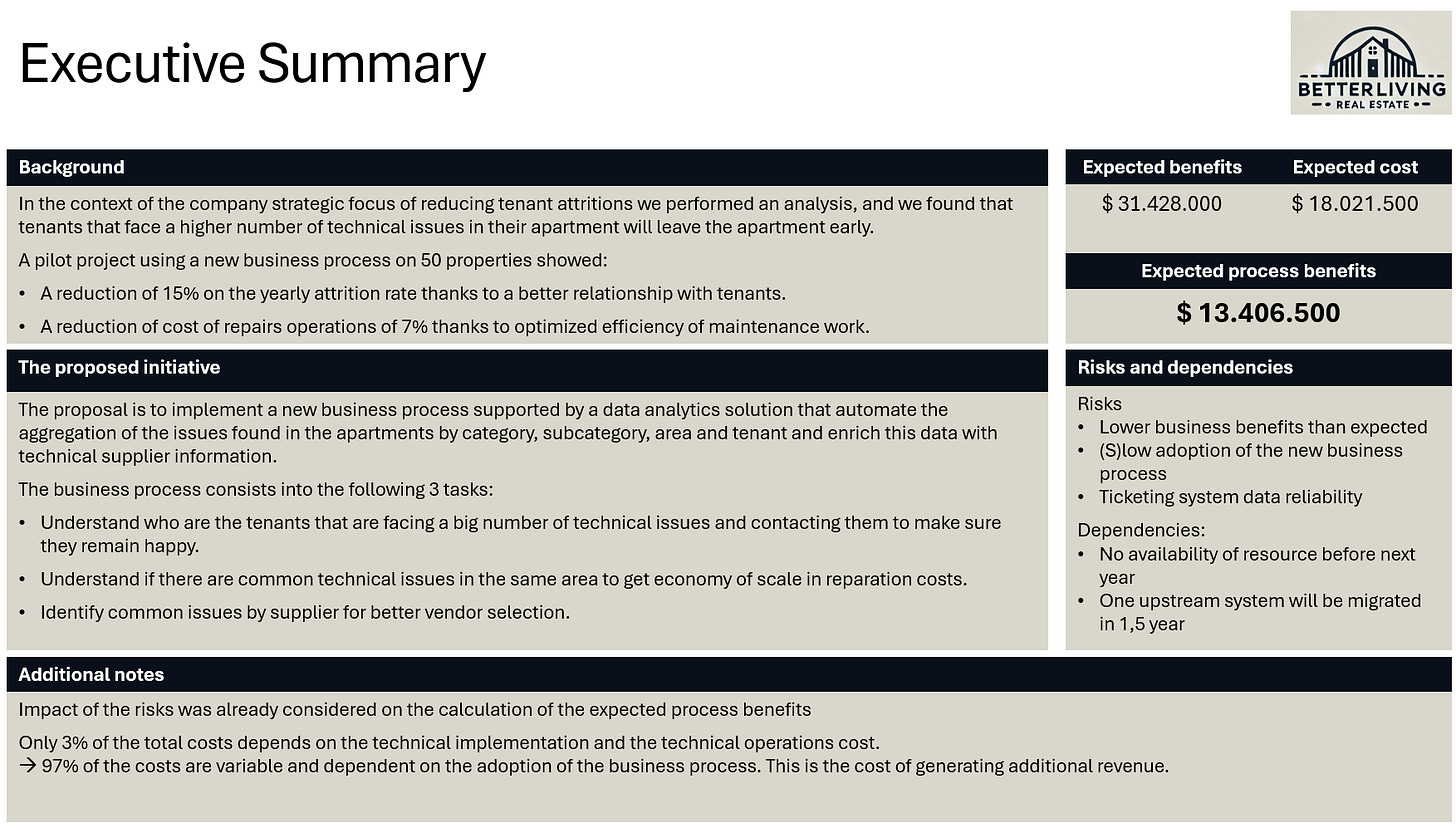#4 - The business case of a data solution
and why the data solution is only a small piece of the puzzle
Reading time: 14 minutes
In the last three newsletters, we explored why it's important to calculate the 'profit' of a data solution, and how to determine both the value it generates and its costs.
I thought it would be useful to connect the dots for you. Today, you'll see a case where all the steps we've discussed come together into a single business case.
Please note that this case is totally hypothetical: the numbers, the business assumptions and the business idea are not real and sometimes unrealistic.
1 - The background
Imagine we are "BetterLiving," a company that manages and rents 3,000 buildings worldwide.
One of the main causes of business loss for Better Living is tenants leaving their apartments for new ones.
In these cases, BetterLiving spends time reviewing apartment conditions, organizing visits for potential tenants, reviewing applications, and preparing new contracts. Apartments may also remain vacant for some time, leading to significant potential revenue loss.
To summarize: tenant turnover is costly for BetterLiving.
2 - The idea
The company hypothesized that tenants facing a higher number of technical issues in their apartments are more likely to leave early.
More apartment issues → Tenants leave early → Higher costs for BetterLiving.
In short, if we can reduce the number of technical issues in apartments or maintain open communication with tenants experiencing more defects, BetterLiving can achieve higher profits.
To validate this assumption, a pilot project was conducted in 50 properties across different locations for one year. The results were:
The average yearly attrition rate decreased by 15% due to improved relationships with tenants.
The cost of repair operations decreased by 7% thanks to improved maintenance work efficiency.
BetterLiving employees worked 2 additional hours per week to manage tasks related to the new business process.
3 - The new data solution project
To summarize, the pilot project gave positive results, and now the company aims to automate the data analysis aspect of this new business process.
The plan is to automate the aggregation of issues found in apartments by category, subcategory, area, and tenant, and to enrich this data with technical supplier information.
The business wants to achieve 3 main goals:
Identify tenants facing a significant number of technical issues and contact them to ensure their satisfaction.
Understand if there are common technical issues in the same areas to achieve economies of scale in reparation costs.
Identify common technical issues with components from specific suppliers and determine the best suppliers for data-driven vendor selection.
BetterLiving uses a ticketing system to track all issues, and data about technical suppliers is hosted in the enterprise data warehouse.
The solution consists of a simple data pipeline moving data from the ticketing system transactional database to the enterprise data warehouse. Then a Power BI report consolidates and visualize the data from the enterprise data warehouse.
There is already a Data Analytics platform team that can cover the requirements without additional infrastructure or hiring.
4 - The business case
Now we impersonate the person that led the pilot project. This business lead wants to get the required budget and the needed support from the company senior management to realize the data solution and to introduce widely a new business process.
To gain approval, we need to build a 'business case' focusing on:
Business benefits
Costs
Risks and dependencies
We must keep in mind one thing: this is a business case.
The whole process is a business process and the data solution we are building is just a tool to enable it.
Our goal is to secure the budget to make this business process operationally sustainable, not just to build the data solution.
One note: normally business cases calculations are divided and shared per year. In this case, for simplicity, I made one single calculation for 5 years directly.
4a - Value generated
To determine if investing in this business process and data solution is worthwhile, we need to understand its business value.
Business value = (New value generated + Cost reduced) *Impacting factors
Thanks to our pilot project pilot, we are lucky to have real numbers.
Decreased attrition rate
As discussed, the average yearly attrition rate decreased by 15%. The yearly cost of tenants’ attrition is the 4% of the total rent.
This means, to simplify, that if we decrease the attrition rate, we decrease by the same amount the cost of attrition.
Considering:
Global Yearly Rent = 18k $ rent per apartment per year * 30 apartments per building * 3000 buildings = 1620M $
We get
Yearly Value generated = yearly cost of tenant attrition * yearly reduction of attrition * Global Yearly Rent = 4% * 15% * 1620 M$ = 9,72 M$
We also want to be cautious about our promises. We're not certain that the pilot project results will precisely translate to the real world, so we don't want to over promise. 😊 Hence, we reduce the value generated by 40%.
Yearly Value generated adjusted = Yearly Value generated * (1 – adjusting factor) = 9,72 M$ * 60% = 5,83 M$
The business process and the data solution are expected to be used for at least five years.
Total Value generated = 5,83 M$ * 5 years = 29,2 M$
Decreased cost of repairs operations
Another result of the pilot project was a 7% reduction in the cost of repairs operations, which is 0.4% of the Global Yearly Rent.
Yearly decreased cost of repairs operations = Yearly cost of repairs operation * reduction of cost * Yearly Market rent = 0,4% * 7% * 1620 M$ = 0,45 M$
Considering again a time interval of 5 years
Total decreased cost of repairs operations = Yearly decreased cost of repairs operations * number of years = 2,27 M$
Summary - Value generated
It is always difficult to forecast the business value generated by the adoption of a data solution.
In this case, it made sense to perform a pilot project to understand the potential benefits. This is not always possible or easy to do. But where possible, it makes sense to try.
It's also important to consider that pilot projects results may differ from those at scale. Hence, adjusting negatively the value generated helps avoid over-promising.
Hera a summary of the business benefits calculation:
4b - Cost of the initiative
Let's start by calculating the initiative's cost. Remember, a business case is not just about technology but about the entire business process.
Development cost
Development costs are mostly comprised of personnel costs. While infrastructure/license costs are common during the development phase, they are typically minor and can be considered later as part of operational costs.
This is just to say: there are other costs on the development phase, but we will ignore in this simulation for simplicity.
Cost of staff
We need to consider both business and IT colleagues working on the development phase. Let’s try to do some estimation.
Business staff
Business colleagues play a crucial role in the success of the initiative. Some key tasks they need to focus on include:
To get all the required approvals needed to move forward with the initiative.
To help on the requirements collection.
To help during testing phase.
To define best solutions when there are technical tool limitations and constraints.
To help on the project management.
To help during the post go-live and to support the adoption process.
BetterLiving has approximately 1,000 property managers across five countries. Considering these tasks, we might need:
1 Product Manager (PM), to consolidate and prioritize key functionalities devoting 50% of his time for 3 months. This person is the key person that will drive the project. The PM will work to get the required approvals, to define and prioritize the functionality of the solution, to take ownership of the business process adoption.
5 Digital Ambassadors (DAs), one per country, dedicating 30% of their time for two months. DAs will engage end-users in all phases requiring their input and serve as the points of contact for adoption initiatives.
Let’s calculate the cost of their involvement in the initiative.
Product manager on a high-salary location:
Considering a salary of 150K $ per year the
Product manager work cost = (150K $ per year / 12 months) * 50% time * 3 months = 19K $
Digital ambassadors on medium-salary location cost:
Considering a salary of 110K $ per year the
DAs work cost = 5 Digital ambassadors * (110K $ per year / 12 months) * 30% time * 2 months = 27,5k $
Business staff cost = 19k $ + 27.5k $ = 46.5k $
IT staff:
The solution consists of a simple data pipeline transferring data from the ticketing system's transactional database to the enterprise data warehouse. A Power BI report then consolidates and visualizes this data.
At first look for the development, we might need:
One Business Analyst that works with the product manager to collect and document the requirements and to perform pre-user testing. Let’s assume one month full time.
One technical colleague from the ticketing system to support database connection and query writing for data transfer to the DWH. Let’s assume 2 weeks full time.
One Analytics Engineer that will build both the data pipeline and the Power BI report. Let’s assume 6 weeks full time.
One QA/test expert (QA) that will test the data solution. Let’s assume 2 weeks full time.
Additional resources for shorter time frames: DevOps engineers, team manager, security team, other experts. Let’s assume 3 weeks full time.
Considering all the IT colleagues working in a high salary location, everybody with the same salary of 130k $ per year we arrive to this calculation:
IT staff cost = (130k $ per year / 12 months) * (1 + 0,5 + 1,5 + 0,5 + 0,75) = 46K $
Total development cost
We know the complete cost of resources, but as mentioned, we are often too optimistic, and we ALL 😊 know that projects often run late. Though this project is small and simple, it's wise to include a "buffer" budget for unexpected costs.
We can calculate this buffer by making larger time estimates or increasing the development cost by a factor. In this case, let’s adjust the total cost by 20%.
Total development cost = (46k $ + 46.5k $) * 120% = 111k $
Operations cost
Once we are live, using this new business process has a cost that we should take into account. Let’s assume we will keep this process and the relative data solution operational for 5 years.
We can remember that:
Operations cost = Human Resources cost + License cost + Infrastructure cost
Human Resources cost
Tech Human Resources cost = Production Support cost + Maintenance cost + Administration cost
In my experience, the Tech Human Resources cost during the operation phase was always roughly estimated at the project's beginning to build the business case. It was later adjusted based on post-go-live experience. Here, we can use a rule of thumb: 20% of the development cost per year of operation.
Tech Human Resources cost = 20% per year * 5 years * 111k $ = 111k $
If you want to calculate this value more accurately you can try to forecast the number of support requests or technical issues you might phase. This depends largely on the number of active users and the complexity of the data solution.
One more thing. Before we mentioned:
“Better Living employees worked for additional 2h per week to cover the tasks of the new business process.”
This means that we need additional property managers or to pay higher salary to cover the additional 2h of work per week.
Let’s assume that the work week is 40h and that the average salary of our property managers is 70k $ per year.
Additional amount of work required: (2h/40h) = 5%
This means that we need to hire 5% new property managers. That’s quite a big impact…
Cost of business process tasks = 1000 employees * 5% *70k $ * 5 years = 17,5M $
What? 17,5 M$? 💵
Ok, this is not a real case. The impact of this cost (97%) on total costs seems unrealistic. The 2h might be overestimated and there are better ways than hiring additional property managers. But there is a point here:
It should be never a surprise that what we build is just a tool to support a business process.
The whole business process has a cost we often do not see as technical staff.
But that we need to consider when we come with ideas, or we develop a solution.
Also, it is not always needed to add the cost of the business process adoption. Sometimes the business process is already there so we do not need to add it.
Sometimes is there and we are automating it: the value of our solution is even higher.
Sometimes is not there but it is required to run the business or for regulatory reasons.
In few words, we need to understand case by case.
License cost and Infrastructure cost
We are assuming that we plan to use an analytics platform already in place. The analytics platform team decided that the license and infrastructure cost is split according to the number of data solutions onboarded despite the complexity required.
The full platform costs 600k $ per year and this project is one of the ten using it.
License and infrastructure cost = 600k$ per year / 10 projects * 5 years = 300k $
There is also a lesson here: sometimes license and platform costs are funny. I saw use cases where there was no need of paying any infrastructure cost since it was paid centrally for the whole company. And cases where you are almost obliged to use a platform managed by a central team where you land paying according to suboptimal criteria (e.g. number of reports or workspaces in Power BI).
This serves as a reminder that the company organization impacts your data solution's cost.
Summary - Cost
With the cost calculations we learn also few things:
The cost of the data solution can be small compared to the ones of the business process we are trying to implement.
License and infrastructure costs can be something you do not have much impact or where you have full control, and you cannot always choose.
The cost of development seems always correct… when you calculate it. But it is often better to overestimate it a bit for unexpected tasks.
You can find the summary of the cost of the data solution in this image:
4c - Risks and dependencies
As part of a business case, we need to highlight the risks and the dependencies of our project.
Risks
Risks can completely cancel the value of projects if realized.
We need to make sure we have a plan to mitigate or cover risk costs.
Let’s make few examples to be clearer.
Lower business benefits than expected
It is possible that, despite the deep analysis of the pilot project results, the benefits of the new business process get realized only partially.
In this case, we considered this risk by lowering of 40% the expected benefits.
(S)low adoption of the new business process
Introducing a new business process is not always easy and its adoption depends on many factors. Slow adoption could lead to delays in realizing the expected benefits.
Ticketing system data reliability
Oh, data quality. We still did not spoke about it, but it is one of the most common causes of poor analytics adoption or, worse, wrong business decisions.
In this case, we do not know yet the overall data quality of the ticketing system data.
We did an initial assessment for the pilot project, and it was good enough in most of the cases… but what happens if five teams of 30 people manages every technical issues only via phone? Or if they just assign any random category to the tickets just because they have to add a category? This will bring to wrong results and the users will know it because they are creating the data. 😅
Dependencies
We saw that we are dependent from both the ticketing system team and the data analytics platform infrastructure.
What a dependency in this case means? Well we can have:
Time dependency: the technical person of the ticket system is not available before next year.
Technology dependency: The out-of-the-box solution we planned to use isn't supported by the analytics platform.
Change management dependency: The ticketing system might migrate to a new tool in one year and half. Does it make sense to invest in creating the data solution now, or is it better to wait?
Again, these concepts are just food for thought.
It's essential to keep in mind that many factors must be considered when building a new data solution. However, we shouldn't be paralysed by complexity.
Sometimes it is important to build something now, just to start, especially if the initiative is small… there might be benefits we did not even consider such as promoting data-driven decision-making.
Here a slide with a summary of risks and dependencies.
5 - Summary
If you arrived here, it was a long read. So let’s try to keep it short 😊
I will not summarize the case now but here a summary slide:
And here a few lessons we've learned:
It is important to consider a data solution as part of a business process. This means that we need to have a holistic approach to understand the true business benefits and costs.
In this scenario, a significant portion of the business process cost comes from its usage. Although it might seem counter-intuitive, this is a real-world consideration.
Being data-driven helps in calculating the business benefits and costs of a process. Without the pilot project we wouldn’t have much data to present the case.
You need to manage risks and dependencies otherwise they will manage you.
I stop here.
Here the business case and the excel file with the calculations.
But the calculations do not matter, and I use them only to help you connecting the dots from the last article. I hope it helped 😊
If you enjoyed this newsletter and haven’t subscribed yet, it might be a good idea to
In the next newsletter, we'll discuss about something different.
If there's a specific topic you'd like to hear about, let me know.
To the next one,
Francesco
Do you want to give a feedback about Better at Data? 📝Do it here












